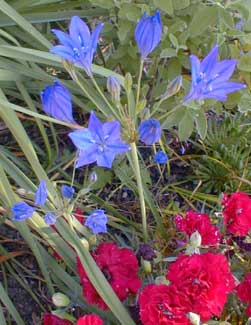
Grassnut; aka:
Blue Brodiaea,
Bloomeria,
Fool's Onion,
Ithuriel's spear,
Long Rayed Triteleia,
Pretty Face,
Starflower,
Triplet Lily, or
Wild Hyacinth
Brodiaea laxa (formerly Triteleia laxa) is native to Northwest Oregon & northern California, where it grows in open grasslands that dry up in summer, making it ideal in gardens that duplicate prairie conditions.
The species grows a foot to twenty inches tall, but the cultivated form 'Queen Fabiola' is often is usually at the shorter end of that range.
It grows from a corm planted in Autumn. We planted several in one of our sunniest best-draining gardens. Brodiaea does not like winters that fall below about 22 degrees F., & needs mulching to get through winters of colder zones. But Puget Sound's microclimate has few enough days into the teens that the Brodiaea usually doesn't suffer from the cold.
This wildflower of the American West has a great many common names because throughout its range, every pioneer town called it something different, yet it never became commonly enough gardened for any single name to settle onto it. "Grassnut" is probably most often used by hikers; it is "Fool's Onion" to old-timers who know that hunters of wild onions are fooled by its resemblance to edible alliums.
Many people call it Ithuriel's Spear. Ithuriel means "Discovery of El," the Canaanite divinity whose name was coopted as a name of Yahweh. Ithuriel was a high-ranking & princely angel who oversaw doings in the Garden of Eden. He is named in Rabbi Moses Cordovero's great kabbalistic work The Orchard of Pomegranates, & doubtless had an ancient oral tradition well before the great 16th Century Rabbi committed any part of Ithuriel's legend to writing. Later grimoires also mention this angel, & Milton mentions him as a cherub.
When the serpent first tempted Eve, it had legs like other beasts, & resembled a toad. When it was in the aftermath of mischief cursed to go forever upon its belly, Ithuriel touched the toadish Satan with his spear, & its legs vanished. In whatever guise Satan appears to this day, the touch of Ithuriel's spear reveals his true form.
It would likely be a much more popular garden flower but for one fault: the thin grassy foliage is no great shakes. As a flower, it is interesting for the three weeks it possesses its richly glassy-blue blooms.
By the time it flowers for June, the foliage is already dying back. While the grass is dying, it does not want to be watered, so a mulch of pumice or pea-gravel may help to keep it from too much moisture. Earlier in the year when the grass is growing it can do with moderate watering. Our usual weather pattern of rainy spring & rainless summer just about suits it, & it is best planted in areas of gardens beyond the reach of water hoses & on stone ledges where rainfall will quickly dry.
 Despite its sub-average foliage, some regard it as preferable to dwarf alliums which it closely resembles, but without the garlicy odors of sundry alliums, having instead a pleasing fragrance. It's additionally interesting for its lilac-blue pollen.
Despite its sub-average foliage, some regard it as preferable to dwarf alliums which it closely resembles, but without the garlicy odors of sundry alliums, having instead a pleasing fragrance. It's additionally interesting for its lilac-blue pollen.Even though it is a native of the lower Northwest, the bulbs are produced for commerce in Holland. The floral industry that sells cut flowers is finding it an increasingly important item because it smells good & the bulbs force so easily at any time of the year, meaning cut flowers can be produced from stored bulbs year-round, with ethylene treatment extending the storage time so that corms can be whipped out to produce another batch of cut flowers as needed.
 I enjoy reflecting upon the very subjects that inspire species names or cultivar names. The present cultivar is named for Queen Fabiola of Belgium, whose portrait is shown on the right.
I enjoy reflecting upon the very subjects that inspire species names or cultivar names. The present cultivar is named for Queen Fabiola of Belgium, whose portrait is shown on the right.This Catholic queen was in turn named for the Christian friend of Jerome, Fabiola, a 4th Century Roman matron who became the patron saint of victims of abuse & adultery, & patron saint of divorce, having herself divorced a bounder & remarried profitably. She was additionally patroness of poverty & illness, having later in her life used her widow's inheritance to found a hospital for the indigent.
The 1949 film poster shown on the left is for Alessandro Blasetti's Italo-Franco film production in St. Fabiola's honor. The film is historically absurd, but well-budgeted & superior to the great bulk of Italian costume spectacles of the following decade. Nor is it is too horridly preachy for non-Christians to enjoy, as it seems to be meant as a "comparative fable," with the Roman persecution of Christians invoking the then-recent Fascist excesses & the Nazi slaughter of Jews.